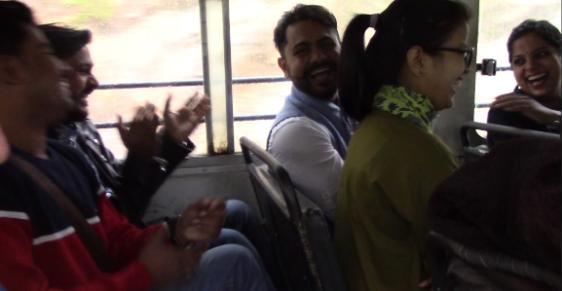Mediating Multilingualism
A project with Amity University, Haryana, Indian Centres for Endangered Languages, and the Jamaican Language Unit of the University of the West Indies, Mona.

The Language Sciences Institute, with support from Soillse and Sabhal Mòr Ostaig, is leading on this project to develop links with Indian and Jamaican colleagues engaged in researching multilingualism and endangered or low-resourced languages. In the first year of the project, 2018-2019, a colloquium was held at Amity University, Haryana, (AUH - the lead Indian institutional partner), as part of a fact-finding tour which also included visits to Centres for Endangered Languages at Jadavpur University, Kolkata, and Visva-Bharati, Santiniketan. A full account, with links to presentations is available in this Soillse report.
In the second year, the focus was on fieldwork which tests out new recording methods and assistive dissemination platforms, as well as the development of a research agenda with a focus on the societal context of language endangerment. Following the impact of the COVID-19 pandemic the attention shifted to online data curation and development on an interim basis, with a focus on potential adaptation of the Clilstore platform to more effectively accommodate Indian languages and scripts. Trial units have been created in four different languages, awaiting further development:
| Assamese | Bangla | Khasi | Tamil |
|---|---|---|---|
In its third year, the Jamaican Language Unit was welcomed as a new partner in the project. Inter alia, the unit conducts research on the Jamaican language, and advocates for the recognition and officialisation of the language, and its teaching to native and nonnative speakers. The Jamaican component of the project comprises the creation of audio and audiovisual materials in the Jamaican language, the provision of transcripts, translations, and related lexicographic work, plus compilation of a 500,000-word corpus.
Strong foundations have now been laid in all these areas of work. As the Jamaican language is not currently adequately provided with online dictionary support, an innovative “Custom Wordlist” approach was developed specifically for this project, and tested out on Clilstore with some samples of Island Voices videos prepared for a Jamaican audience.
Another workstream has launched the “Taak Tu Mi” series of podcasts in the Jamaican language on the Braadkyaas Jamiekan YouTube channel.
In the meantime, relaxation of lockdown restrictions in Spring 21 in India enabled the engagement of additional research assistants around parts of the country, who undertook new data collection with a view to electronic documentation and online dissemination. The AUH team has set up a dedicated Mediating Multilingualism website to bring together the Indian work in the project.
A sample Clilstore unit in Hadoti was also produced using the Custom Wordlist approach to test out its effectiveness with Indian languages lacking online dictionary support. Over the course of the project a number of Island Voices videos were also rendered in various other Indian languages in similar style.
| Bangla | Hindi | Tamil |
|---|---|---|
In the last few weeks of the funded period for the project, the university partners in Scotland, India, and Jamaica discussed themes of common interest with UK-based community language speakers, stimulated by brief extracts from the final session of Saoghal Thormoid. These discussions were recorded, and have been collected on the separate Talking Points with Norman Maclean page.
The Mediating Multilingualism project is supported by the Global Challenges Research Fund.
This video reports on the International Language Fest for Indigenous and Endangered Languages held at North-Eastern Hill University (NEHU), Shillong, as part of the 2019 International Year of Indigenous Languages. The film is multilingual and presented in Gaelic, while being fully subtitled in English. The main film lasts under 12 minutes, and is preceded by a two and a half minute introduction, and followed by a discussion (6 minutes) and brief postscript.